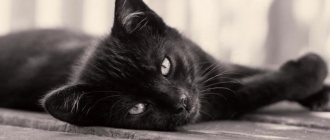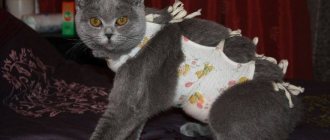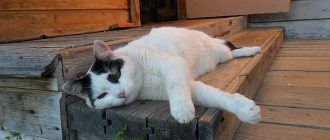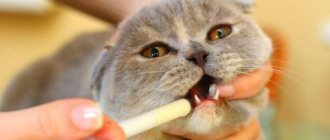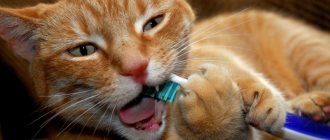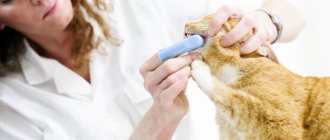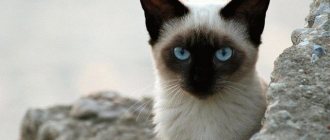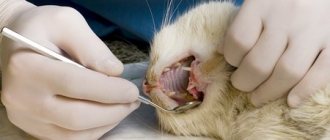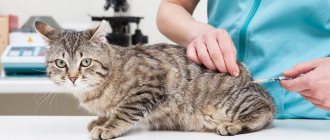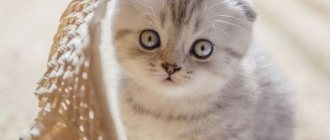Four-legged friends come into our home in a variety of ways. Someone purchases purebred kittens from breeders - in this case, all the details of their health status, as well as their exact age, are stored in the veterinary passport issued upon purchase. However, not all people go to professionals to buy a long-awaited pet. Owners of cats who purchased them at fairs, secondhand, or even picked them up on the street may not even be aware of the real age of their pet (especially if it found its home already in adulthood). We will talk about how to determine the age of a cat in this article.
How to determine the age of a cat
Why find out the age of your pet?
The question of whether awareness is needed in a pet’s age is a logical question that has visited owners more than once. Whether we are dealing with a two-, four-, or six-year-old cat – does it matter? Indeed, some owners, regardless of the age of their pets, feed them the same food and do not change their caring habits for years.
Knowing your cat's age allows you to more effectively monitor his well-being.
Meanwhile, ignoring age leads to ignoring age-related characteristics and the inevitable changes in the body that occur in a cat’s body as it grows. The simplest example is that as cats age, their teeth wear down and turn yellow, which leads to the need to regulate the pet’s diet. It’s not for nothing that even the most budget-friendly foods have lines distributed by age.
What does the age of a cat affect?
Among the main reasons why you need to know the approximate age of a cat are the following:
- Knowing the age of your pet, you can more rationally distribute its physical activity and ensure that the cat does not become overtired. Many inexperienced owners literally “flirt” with older cats, whose activity is significantly reduced compared to young cats. The opposite situation is also possible - kittens at a young age lack play activity, which provides an outlet for accumulated energy;
Physical activity is important for both older and younger individuals, but it is important to dose it correctly
- The age of the cat must also be taken into account when monitoring its health. There are diseases that older cats are most susceptible to, such as cataracts. Caring for and maintaining the well-being of older and younger cats are fundamentally different;
Each age of the cat has its own approach to choosing vitamin complexes and medications.
Knowing your pet's age will allow you to choose the best nutrition plan that meets the needs of your pet. As mentioned above, cats' teeth do not last forever, even with daily care. With age, the fangs wear down, the teeth turn yellow, acquiring stones and caries. Older individuals are very reluctant to eat dry food, since it is a real test for their teeth, while many young individuals can use it.
Many cats change their food preferences as they age.
As already mentioned, one of the most common mistakes is ignoring the age of the cat when calculating its diet. Refusal of the same food, which an inattentive owner may take as a sign of capriciousness, ultimately often turns out to be an indirect request for a change in food. In addition, older cats lose their sense of smell, which prevents them from fully smelling food and developing an appetite. You can learn more about the specifics of feeding older pets below.
Features of feeding older cats
Determining the age of a cat by the condition of its teeth
A particularly effective method for determining a cat’s age is by looking at its teeth in the first months of their life, since the replacement of baby teeth with molars follows a fairly strict schedule. Subsequent changes in the condition of the enamel and the strength of the teeth themselves also obey certain rules, but have their exceptions to the rules.
Despite their strength, without proper care, cat fangs quickly become coated with plaque.
The fact is that in addition to the number of years spent in the cat’s jaw, the condition of the teeth is also influenced by such factors as:
- Lifestyle. The teeth of a well-groomed domestic cat that does not neglect visiting the dentist will be strikingly different from the teeth of a stray cat of the same age. Care allows both human and cat teeth to maintain a neat appearance and high functionality for a long time;
The need to grind teeth on unsuitable materials leads to their rapid wear
- Heredity. It is known that all breeds have certain weaknesses. Some breeds have jaw abnormalities and simply weak teeth, which are passed on from generation to generation until your pet gets it. In this case, the condition of the teeth may even age him and not provide correct information about his age.
The “life path” that each cat’s teeth go through is presented in the table below.
Table 1. Age-related changes in cat teeth
| Age | Dental condition |
| Three to five weeks | The first baby teeth appear |
| Six months | Baby teeth are completely replaced by molars |
| One year | At this age, your teeth are in the best possible condition. There are no tartar or yellow plaque |
| One and half year | The first, barely noticeable signs of wear appear on the cat's teeth, consisting in the abrasion of the central incisors of the lower jaw. |
| Two years | Tooth enamel begins to acquire a yellowish tint, tartar and other dental deposits gradually accumulate |
| Four to five years | The wear of the central incisors is pronounced; the middle incisors suffer the same fate. |
| Five to six years | Upon closer examination, abrasions on the fangs are visible. The outer incisors of the upper jaw are subject to wear. There are disruptions in the pigmentation of tooth enamel, resulting in yellowish and dark spots |
| Seven years | All existing incisors are worn out (some may have fallen out), and abrasions on the fangs are clearly visible |
| Ten years | The cat is experiencing gradual tooth loss. First, as a rule, the central incisors become unusable, then it comes to the middle and extreme ones. |
| Fifteen years | If a cat lives to this age, then she has to come to terms with the loss of fangs - one of the means of effective self-defense |
Learn more about maintaining dental health
As you can see, the age of a cat has a significant impact on the condition of its teeth. The lifestyle an animal can afford depends on the health of its teeth. Unfortunately, it is rare that an owner is puzzled by the condition of his pet’s teeth, wanting to choose the right type of food for him. Meanwhile, it is enough for the pet owner to show it to a specialist from time to time and consult about the condition of the animal’s teeth in order to avoid their premature wear.
The condition of the oral cavity influences the choice of the appropriate type of food
To maintain strong teeth and a clean mouth, special “dragées” may be prescribed, which must be chewed thoroughly. In some cases, owners are advised to use special toothpaste to prevent caries and stones.
Timely removal of tartar will allow your pet to keep its teeth.
How to find out the age of a kitten
Finding out the age of a kitten is much easier than finding out an adult animal. Based on development and external signs, calculations can be made with a very small error.
Tough
Teeth are a good criterion to estimate how old a kitten is. Baby teeth begin to appear at 2 weeks. The process is completed by 6-8 weeks. Then, at about 4 months, the milk ones fall out and the main ones begin to appear. Knowing these data, you can quite accurately calculate the age up to weeks.
| Teeth | Age |
| Dairy milk appears: | |
| incisors | 2-3 weeks |
| fangs | 3-4 weeks |
| premolars | 3-6 weeks |
| Molars (permanent) teeth are being cut: | |
| incisors | 3-4 months |
| fangs | 4-5 months |
| premolars | 4-6 months |
| molars | 4-6 months |
By 7 months, the cat should have all adult teeth.
By weight
This method is suitable for determining the age of a kitten. Moreover, the younger the pet, the easier it is to understand how many months it is.
Determining the age of a cat by appearance
The easiest way to identify a cat by age, the first one that comes to mind, is associated with an analysis of its external features. However, the results of such analysis are not always clear. As cats age, they do not develop wrinkles that are typical for humans, and changes in fur are not so noticeable. In addition, other factors may also influence the condition of a cat’s coat:
- presence or absence of planned water procedures;
- quality of diet;
- the number of diseases suffered that lead to deterioration of the coat;
- timely treatment against parasites (ticks, fleas and other blood-sucking creatures), or its absence.
Not all older cats have coat changes so obvious that they allow one to determine the onset of old age.
The owner's care for his pet again allows the cat to deceive time and look “younger” than he really is. However, not even the most well-groomed cat can stop the inevitable age-related changes, including appearance.
Wool condition
Of course, there is no exact time frame that would allow us to determine the age of a cat based on the impression of its fur. There are only a couple of generalized signs that can indicate the degree of maturity of an animal.
The fur of older cats loses its former silkiness without proper care.
Table 2. Condition of a cat’s coat depending on age
| Age | Wool condition |
Kittens up to one year old | The fur of young cats is soft and silky to the touch. Mats or bald spots are very rare and indicate possible diseases or immunodeficiency |
Cats up to seven years old | Mature pets can also boast of the excellent condition of their fur coat. Smooth and fluffy, with proper care it retains this appearance for many years. Both the overall “pattern” and each individual hair can be clearly seen. No gray hair |
Field cats eight years old | In older cats, the fur loses its former softness and tends to form tangles that are difficult to comb. It is worth noting that this rule does not apply to all aging pets. Some animals, even at an advanced age, retain their coat in its original form, but gray hair makes itself felt, capturing entire segments of the coat |
The method of determining the age of a cat by its fur has a number of disadvantages. In addition to the inevitable errors, there are breeds to which the wool quality indicator simply does not apply. These breeds include all cats with no fur, or with very short and coarse guard hair, which does not allow age-related changes to be detected according to this criterion.
Condition of the musculoskeletal system
Skeletal changes are not the first sign that comes to mind. Moreover, with proper distribution of physical activity, cats are able to maintain ease of movement and agility until a very old age. Despite this, it is the musculoskeletal system that is one of the most reliable indicators of the degree of maturity of an animal.
The strong joints of young individuals allow them to do a variety of “tricks” without harm to health
The kitten's skeleton develops unevenly, due to the rapid development of the body, which is difficult to keep up with. The kitten gains several grams per day, which leads to an increase in the load on the joints (considering the kitten’s initial weight). In this regard, a teenage cat has the following physiological characteristics:
- Disproportionately elongated paws, giving the impression of “stilts”;
- Large ears, compared to the ears of more mature individuals of the same breed (there are exception breeds for which large ears are the norm, for example, the Oriental cat);
- The young pet's body is awkward and lanky, giving the impression that it has not fully undergone the transformation into its final state.
Disproportional features are a natural consequence of a rapidly growing organism
Young and mature individuals develop muscles, thanks to which the body begins to appear proportional and graceful. At the end of puberty and puberty, the cat acquires features characteristic of its breed. Other manifestations of animal skeletal maturity include the following:
- The appearance of muscle relief;
- Ease and grace of movements;
- Ability to overcome various obstacles and make long distance jumps.
The formation of muscle relief is especially striking in short-haired breeds
Elderly animals, even if they maintain their dashing prowess, by the age of seven or eight years, one way or another, show the first signs of aging, which are not so noticeable at first. Such manifestations include:
- A “failed” spine and protruding shoulder blades;
- The gait loses its former lightness. Some movements seem to be difficult for an older cat;
- The muscles become decrepit, and their overall volume decreases.
The musculoskeletal system of older cats is not ready for heavy loads, which often bring discomfort.
All these signs are clearly visible if they are accompanied by thinness, which is often characteristic of aging individuals. If the body of an elderly cat has excess fat, all the criteria mentioned above are smoothed out (except for the difficulty of movement - with excess weight this is the first thing to appear).
By the eyes
Determining age by the eyes is relevant for small kittens; it is not possible to apply this method to adult pets due to the peculiarities of biological development. How to determine the age of a cat from the first days of life is important for maintaining the diet of newborn animals that find themselves, for example, without a mother.
Newborn kitten
On the first day, newborn kittens are blind. At about 7 to 10 days of age, the eyes begin to open. Already open, but narrowed eyes indicate that the babies are 2-3 weeks old. By 3-4 weeks of age, kittens’ eyes are already fully open.
The color of the eyes can tell how old a kitten is. As a rule, instability of iris coloration is observed at the age of 6 - 7 weeks.
Correlation between human and cat ages
The desire to convert human years into cat years has probably driven man for more than a hundred years. Since it is hardly possible to draw an unambiguous analogy between the age of a person and the age of a cat, people resort to various tricks in order to identify a scheme by which it would be possible to approximately calculate the age of a cat.
Converting human years to cat years presents a number of difficulties.
The most common scheme allows you to calculate the age of a cat by multiplying the number of light years it has lived by 7. Of course, such a calculation system has errors and does not suit many people.
Problems of transferring human standards
The question of how legitimate the ambitious desire to calculate the exact age of a cat by human standards remains open. It is important to remember that cats develop in ways that are fundamentally different from humans.
The development rates of the cat's body and the human body have little in common with each other
Yes, cats go through phases of “infancy”, “childhood”, “adolescence”, “youth” and “maturity”. Blooming and fading are characteristic of them in the same way as other living organisms. Meanwhile, one can hardly derive any practical benefit from the assumption that Nikolai the cat is 35 cat years old. However, such methods of calculation allow the owner to “bring the animal closer” to himself and make it more understandable from a human point of view.
We should not forget that attempts to transfer the peculiarities of emotional perception, thinking and other psychological characteristics of a person to a cat are only a projection that has a distant relationship to reality.
A comprehensive ratio of cat and human ages is shown in the table below.
Cat to human age ratio
Youth
How to calculate the age of a cat by human standards? The table indicates that a cat at 18 months (1.5 years) corresponds to a 20-year-old human. Youth is coming, the very prime of a cat’s life. It lasts up to 5 years, which corresponds to 36-40 years by human standards.
During this period, the cat is stronger than ever, dexterous and tireless. It is animals of this age that most often become winners of exhibitions; they are optimally suited for breeding. At the age of 7, purebred pets are already taken out of breeding, as the risks for the mother and offspring increase.
How long do domestic cats live?
The average life expectancy of a domestic cat is 15-16 years, provided that the pet is cared for, monitored and promptly shown to a veterinarian. When compared with stray cats, who live on average 5-7 years, domestic cats turn out to be real long-livers.
The lifespan of a pet depends both on genetics and on the care of the owner
The following conditions contribute to the longevity of a pet:
- Proper nutrition that meets the needs and health of the pet;
- Vaccination, which allows you to strengthen the cat’s body even in sterile home conditions;
- Physical activity, thanks to which the cat’s muscles do not become flabby and remain in good shape until old age;
- Routine examinations for the presence of fleas, ticks, roundworms, worms and other parasites that cause deep damage to the health of the animal;
- Sterilization, which protects cats from unwanted pregnancies in case they have access to the outdoors.
Playing with your pet allows him to compensate for his lack of movement in an apartment.
Video - what affects a cat's life expectancy?
Influence of breed on lifespan
It is difficult to speak with certainty about a clear connection between breed and life expectancy. There are lists that allow you to correlate the breed and the approximate number of years to which its representative will live, but there is no need to talk about exact data. Among the long-livers are the following breeds:
- Australian Smoky Cat;
- Japanese Bobtail;
- Neva masquerade cat;
- Maine Coon;
- Siamese cat;
- American Shorthair;
- Manx.
Anomalies in the Manx body structure did not affect the number of years allotted to them
Among the cat breeds whose life expectancy is quite short are the following:
- Snowshoe;
- Bombay cat;
- Russian blue cat;
- Abyssinian cat;
- Ural rex.
The average lifespan of a Snowshoe is only 10 years
It is worth considering that life expectancy is influenced not only by the breed, but also by the genetics passed on to your pet by its descendants. If a cat is predisposed to a number of serious diseases, then even belonging to a long-lived breed will not save it from an earlier death. Conversely, representatives of the breed, which do not have much time allotted, can live much longer than the “norm” with proper care and good heredity.
Cat Rubble, who celebrated her thirtieth birthday, continues to live a fulfilling cat life
By the way! The oldest cat today is the Rubble cat, originally from the UK. In early summer 2021, she celebrated her thirtieth birthday. The long-lived woman belongs to the Maine Coon breed. The record for the longest life lived belongs to Cream Puff the Cat, who died in 2005 at the age of 38.
